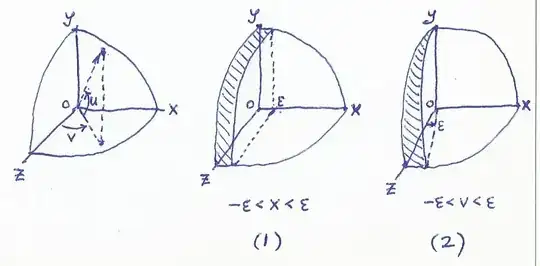Background
Suppose that we are using a simplified spherical model of the Earth's surface with latitude $u \in (-\frac {\pi} 2, \frac {\pi} 2)$ and longitude $v \in (-\pi, \pi)$. Restricting attention to the hemisphere, $H$, where $u, v \in (-\frac {\pi} 2, \frac {\pi} 2)$, a simple map projection from $H$ can be obtained by just taking the $x$ and $y$ coordinates via $x = \cos u \sin v$ and $y = \sin u$, which is a smooth one-to-one transformation on $H$. Now, picking a point with coordinates $(U, V)$ on $H$ uniformly according to surface area, the joint density of $U$ and $V$ is $$f_{U, V}(u, v) = \frac 1 {2\pi} \cos u, \quad \lvert u \rvert, \lvert v \rvert < \frac {\pi} 2.$$
Question
$(a)\quad$ Find $\mathbb{E}[\lvert \sin U \rvert \mid V = 0]$.
$(b)\quad$ Find $\mathbb{E}[\lvert Y \rvert \mid X = 0]$.
$(c)\quad$ Observe that $\lvert Y \rvert = \lvert \sin U \rvert$ and the event $\{X = 0\}$ is exactly the same as the event $\{V = 0\}$. How is it possible that $\mathbb{E}[\lvert Y \rvert \mid X = 0] \neq \mathbb{E}[\lvert \sin U \rvert \mid V = 0]$?
My working
I have omitted intermediate steps and only shown the essential parts to minimise the length of this post.
$(a)$
$$\begin{aligned} \because f_{U \mid V = v}(u) & = \frac 1 2 \cos u,\quad \lvert u \rvert, \lvert v \rvert < \frac \pi 2 \\[5 mm] \therefore \mathbb{E}[\lvert \sin U \rvert \mid V = 0] & = \int^{\infty}_{-\infty} \lvert \sin u \rvert \left(\frac 1 2 \cos u\right)\ \mathrm{d}u \\[5 mm] & = \int^{\frac \pi 2}_0 \sin u \cos u\ \mathrm{d}u \\[5 mm] & = \frac 1 2 \end{aligned}$$
$(b)$
$$\begin{aligned} \\[5 mm] \because f_{X, Y}(x, y) & = \frac 1 {2 \pi \sqrt{1 - y^2 - x^2}}, \quad x^2 + y^2 < 1 \\[5 mm] \therefore f_{Y \mid X = x}(y) & = \frac {\frac 1 {2 \pi \sqrt{1 - y^2 - x^2}}} {\int^{\sqrt{1 - x^2}}_{-\sqrt{1 - x^2}} \frac 1 {2 \pi \sqrt{1 - y^2 - x^2}}\ \mathrm{d}y} \\[5 mm] & = \frac 1 {\pi \sqrt{1 - y^2 - x^2}}, \quad x^2 + y^2 < 1 \\[5 mm] \implies \mathbb{E}[\lvert Y \rvert \mid X = 0] & = \int^{\infty}_{-\infty} \frac {\lvert y \rvert} {\pi \sqrt{1 - y^2}}\ \mathrm{d}y \\[5 mm] & = \frac 2 \pi \int^1_0 \frac y {\sqrt{1 - y^2}}\ \mathrm{d}y \\[5 mm] & = \frac 2 \pi \end{aligned}$$
$(c)\quad$ Although $\lvert Y \rvert = \lvert \sin U \rvert$ and the event $\{X = 0\}$ is indeed identical to the event $\{V = 0\}$, we must be mindful of the coordinate systems in play here. In particular, there are two - the $(x, y)$ plane and the $(u, v)$ plane, which are not identical but related by a transformation. Thus, since $\lvert Y \rvert$ and the event $\{X = 0\}$ concern the $(x, y)$ plane, while $\lvert \sin U \rvert$ and the event $\{V = 0\}$ concern the $(u, v)$ plane, it follows that $\mathbb{E}[\lvert Y \rvert \mid X = 0] \neq \mathbb{E}[\lvert \sin U \rvert \mid V = 0]$.
I think my answers to $(a)$ and $(b)$ are correct, but I am not sure about my answer to $(c)$, so any intuitive explanations will be greatly appreciated!
